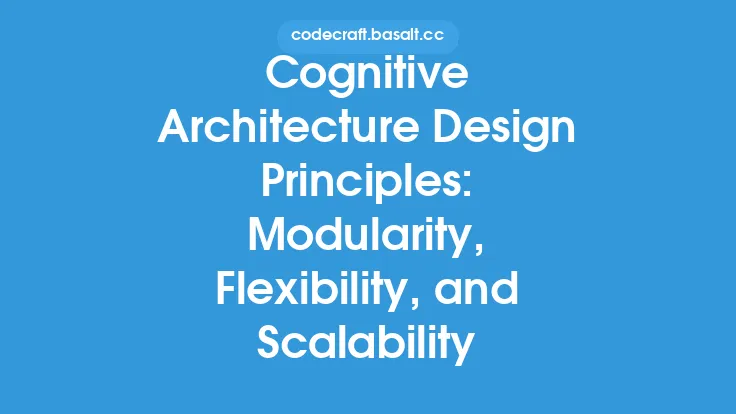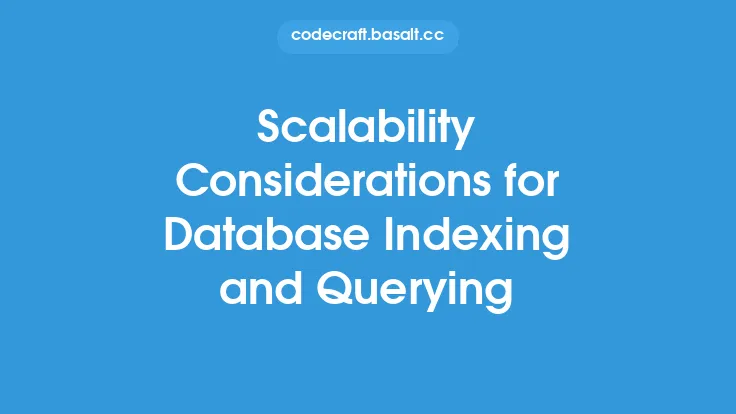When designing a database, it's essential to consider the principles that will enable it to scale and remain flexible as the application or system it supports grows and evolves. A well-designed database is critical to ensuring the performance, reliability, and maintainability of the overall system. In this article, we'll explore the key database design principles for scalability and flexibility, providing a foundation for building robust and adaptable database systems.
Introduction to Scalability and Flexibility
Scalability and flexibility are two closely related concepts in database design. Scalability refers to the ability of a database to handle increased load and growth without compromising performance. This can include increases in data volume, user traffic, or query complexity. Flexibility, on the other hand, refers to the ability of a database to adapt to changing requirements and use cases without requiring significant redesign or reimplementation. A flexible database design can accommodate new features, data structures, or querying patterns with minimal disruption to the existing system.
Normalization and Denormalization
One of the fundamental principles of database design is normalization. Normalization involves organizing data into tables to minimize data redundancy and improve data integrity. There are several normalization rules, each with its own set of guidelines for structuring data. The most common normalization rules are:
- First Normal Form (1NF): Each table cell must contain a single value.
- Second Normal Form (2NF): Each non-key attribute in a table must depend on the entire primary key.
- Third Normal Form (3NF): If a table is in 2NF, and a non-key attribute depends on another non-key attribute, then it should be moved to a separate table.
However, in some cases, denormalization may be necessary to improve performance. Denormalization involves intentionally violating normalization rules to reduce the number of joins required to retrieve data or to improve query performance. This can be particularly useful in systems with high transaction volumes or complex querying patterns.
Data Modeling and Entity-Relationship Diagrams
Data modeling is the process of creating a conceptual representation of the data in a database. Entity-Relationship Diagrams (ERDs) are a common tool used in data modeling to visualize the relationships between different data entities. ERDs consist of entities (tables), attributes (columns), and relationships (links between tables). A well-designed ERD can help ensure that the database structure is logical, consistent, and easy to maintain. When creating an ERD, it's essential to consider the key entities, attributes, and relationships in the system, as well as any constraints or rules that govern the data.
Indexing and Query Optimization
Indexing is a critical aspect of database design, as it can significantly improve query performance. An index is a data structure that facilitates quick lookup and retrieval of data. There are several types of indexes, including:
- B-tree indexes: Suitable for range queries and ordered data.
- Hash indexes: Suitable for equality queries and unordered data.
- Full-text indexes: Suitable for text search queries.
When designing a database, it's essential to consider the querying patterns and create indexes that support those patterns. Additionally, query optimization techniques, such as rewriting queries, using stored procedures, and leveraging query caching, can further improve performance.
Partitioning and Sharding
As databases grow, it may become necessary to distribute data across multiple servers or storage devices to improve performance and scalability. Partitioning involves dividing a large table into smaller, more manageable pieces, while sharding involves dividing data across multiple servers or databases. There are several partitioning schemes, including:
- Range-based partitioning: Data is divided based on a specific range of values.
- List-based partitioning: Data is divided based on a specific list of values.
- Hash-based partitioning: Data is divided based on a hash function.
Sharding, on the other hand, involves dividing data across multiple servers or databases, often based on a specific key or attribute. This can help improve performance, reduce latency, and increase scalability.
Data Types and Storage
The choice of data types and storage mechanisms can significantly impact database performance and scalability. It's essential to choose data types that are suitable for the specific use case and to consider factors such as storage space, query performance, and data integrity. Some common data types include:
- Integer: Suitable for whole numbers.
- String: Suitable for text data.
- Date/Time: Suitable for date and time values.
- Binary: Suitable for binary data, such as images or videos.
When designing a database, it's also essential to consider the storage mechanisms, such as disk storage, solid-state drives (SSDs), or cloud-based storage. Each storage mechanism has its own set of characteristics, such as performance, capacity, and cost, that must be carefully evaluated.
Security and Access Control
Database security and access control are critical aspects of database design. It's essential to ensure that sensitive data is protected from unauthorized access and that access is granted only to authorized users. Some common security measures include:
- Authentication: Verifying the identity of users.
- Authorization: Controlling access to data and resources.
- Encryption: Protecting data from unauthorized access.
- Access control lists (ACLs): Controlling access to specific resources.
When designing a database, it's essential to consider the security requirements and to implement measures that ensure the confidentiality, integrity, and availability of data.
Conclusion
Database design is a critical aspect of building robust and scalable database systems. By following the principles outlined in this article, developers can create databases that are flexible, scalable, and performant. It's essential to consider factors such as normalization, data modeling, indexing, partitioning, and security when designing a database. Additionally, staying up-to-date with the latest technologies and best practices can help ensure that the database remains relevant and effective over time. By investing time and effort into database design, developers can create systems that support the growth and evolution of their applications, ensuring a strong foundation for future success.





